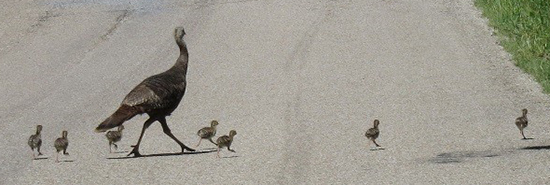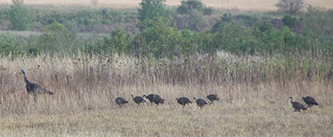
Wild turkey hen with seven poults.
Brought to you by WBIW News and Network Indiana
Last updated on Wednesday, July 11, 2018
(UNDATED) - Help the Department of Natural Resources Division of Fish & Wildlife monitor summer production of wild turkeys by recording wild turkey sightings during July and August using our online survey tool.

Wild turkey hen with seven poults.
Wild turkey summer production success is critical information needed for managing wild turkey populations. The turkey brood survey is now open through August. The public can report observations of wild turkey hens and their young poults here.
Why count turkeys?
Brood surveys provide useful estimates about annual production by wild turkey hens and the survival of poults (young turkeys) through the summer brood-rearing period. Summer brood survival is generally the primary factor influencing wild turkey population trends. Information on summer brood survival is essential for sound turkey management. Information gathered through the brood survey includes:
What is a wild turkey brood?
A wild turkey brood is composed of at least one adult hen with young (poults). As the summer progresses, multiple broods may gather into what is termed a "gang" brood with several adult hens and multiple broods of poults of varied ages. During summer, adult gobblers (male turkeys) play no role in raising a brood and either form small male only "bachelor" flocks of or are observed as a single gobbler.
No gobblers should be reported.

Wild turkey hen with eight poults.
What should I report if I see a turkey brood or some turkey hens without poults?
Please provide as accurate a count of both hens and poults as possible. It is also just as important to record observations of hens without poults. Don't compile multiple observations as one report, instead report each different observation separately, even if observations of different broods are made on the same day in the same county.
Understand that by mid to late August, turkey poults are normally about two-thirds the size of an adult, and a juvenile gobbler (jake) can be about the same size as an adult hen. Suspected repeat observations of the same turkeys during the same month should not be recorded.
1340 AM WBIW welcomes comments and suggestions by calling 812.277.1340 during normal business hours or by email at comments@wbiw.com
© Ad-Venture Media, Inc. All Rights Reserved.